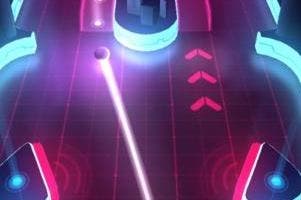Stop everything and play PinOut
It's what Umberto Eco would have wanted.
Umberto Eco had some pretty interesting insights into pinball. Tips, even. Spoiler alert: "You don't play pinball with just your hands." With you so far, Professor. "You play it with the groin too." Um...?
"The pinball problem is not to stop the ball before it's swallowed by the mouth at the bottom, or to kick it back to midfield like a halfback," he continues. "The problem is to make it stay up where the lighted targets are more numerous and have it bounce from one to another, wandering, confused, delirious, but still a free agent." So what's the trick? "You achieve this not by jolting the ball but by transmitting vibrations to the case, the frame, but gently, so the machine won't catch on and say Tilt. You can only do it with the groin." And, by logical extension, the conclusion: "A female groin is required, one that interposes no spongy body between the ileum and the machine." Thanks, Umberto. I have lived with that phrase "spongy body" ever since I first read Foucault's Pendulum. I guess that's the price we pay for literature.
Anyway, I dearly wish that Umberto Eco had lived to see PinOut - although, granted, he would have struggled to play it with his groin, as the whole thing runs on a phone. PinOut is ingenious and stylish. It's pinball, but it never ends. Get the ball to the top of the table, and you'll find there's a gap that allows it to move onto another table, and another beyond, and another beyond that. Neon witchcraft, of course, drawn in taut, slick bars and curves of neon. You have sixty seconds to get as far as you can, but regular time extensions mean that you will never play for only sixty seconds.
God, it is a beauty. So simple! The dual flippers of pinball reduced to taps on the left or right of the screen. Those flippers become more than just a means of propelling you up the tables, they become sort of impromptu save points, moments to rest the ball for a few seconds, if you can face that, before proceeding further into pinball Spook Country. The elegant threading of ramps and bridges you race across make me wonder if pinball didn't find a spiritual home deep in the spaghetti junctions of southern California, and the endless ease of the whole thing makes me wonder if we weren't born hardwired for it, a mechanical video game that will never truly be outmoded.
Man, most surprising is this: I have encountered stories amongst the tables. Not just through the power-ups or the odd mini-games that occasionally pop in, but through quirks of physics, like the time I accidentally gave a ball - I was on a serious hot streak here - too little force as it pootled along a ramp that turned out to be much longer than I had expected. It never slowed down enough to roll back to me for another flip. Instead it just crawled forward, eating the precious seconds I had built up, and meaning that when it eventually flopped out into the next arena it came to rest on the flipper just as the game kicked me back to the hi-score table, defeated.
PinOut is free, but you can pay a little bit to make the game so much worse by saving your checkpoints for you. A bit of a dilemma, this one, as I want to give the developers some money for making something so special, but I don't want to ruin the purity of it in the process. I think I will pay up, as pinball itself is one of those games where money is baked into the whole proposition from the start, your coin rattling through the hidden spaces of the interior even as it allows your ball bearing to curve over the machine's glossy outer surfaces. Pinball, eh? Pinball!










